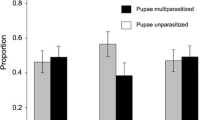Abstract
Three species of Tachinids (Lixophaga diatraeae T.T.,Paratheresia claripalpis van der Wulp, andMetagonistylum minense T.T.) were used to study intrinsic larval competition under laboratory conditions in Barbados.
When equal numbers of freshly hatched larvae ofLixophaga andParatheresia were simultaneously inoculated into fullgrown moth borer caterpillars, both parasite species survived in equal proportions. In simultaneous inoculations ofMetagonistylum andLixophaga the first-mentioned species was clearly inferior (ratio about 1∶2). In inoculations withMetagonistylum andParatheresia the intrinsic inferiority of the first-mentioned species was still more pronounced (ratio 1∶5). When maggots of all three species were inoculated simultaneously the ratio of parasite survival forLixophaga: Paratheresia: Metagonistylum was approximately 2∶2∶1, indicating again thatMetagonistylum is the inferior species, whereasLixophaga andParatheresia are equally competitive.
The results described above did not change appreciably when one species was given a numerical advantage over the other, e.g. when three maggots ofMetagonistylum were simultaneously inoculated with only one maggot ofLixophaga (orParatheresia). In most of these tests,Lixophaga andParatheresia still remained the superior species.
When maggots of one species were inoculated two days in advance of the other species — i.e. when one species had a developmental advantage — the earlier inoculated species usually survived in greater proportions than it would have in simultaneous inoculations. Under Barbados conditions the larval period ofLixophaga is the shorter (5 days), followed byMetagonistylum (6–7 days), and the longest larval period occurs inPara heresia (7–9 days). When a species with a faster development was inoculated two days in advance of a species with a slower development (e.g.Lixophaga two days in advance ofParatheresia), the developmental difference between the two species was magnified and the earlier inoculated species was then clearly the superior one. When, on the other hand, a species with slower development was given a two-day advantage in time the slower growing species survived in greater proportions than it would have done in simultaneous inoculations. The developmental advantage of its competitor was, in this case, eliminated.
Résumé
Trois espèces de tachinaires (Lixophaga diatraeae T. T.,Paratheresia claripalpis van der Wulp, etMetagonistylum minense T. T.) furent utilisées pour étudier la compétition larvaire dans des conditions de laboratoire à la Barbade.
Quand des nombres égaux de larves néonates deLixophaga et deParatheresia étaient simultanément inoculées dans des chenilles mûres du foreur, les deux espèces de parasites survécurent dans des proportions égales. Dans des inoculations simultanées deMetagonistylum et deLixophaga, la première de ces espèces fut nettement inférieure (rapport environ 1 ∶ 2). Dans des inoculations avecMetagonistylum etParatheresia, l'infériorité intrinsèque de la première espèce susmentionnée fut encore plus prononcée (rapport 1 ∶ 5). Quand des larves des trois espèces étaient inoculées simultanément le rapport de survie des parasites pourLixophaga: Paratheresia: Metagonistylum fut approximativement 2 ∶ 2 ∶ 1, indiquant à nouveau queMetagonistylum est l'espèce inférieure, tandis queLixophaga etParatheresia sont d'égale valeur compétitive (tableau 1).
Les résultats décrits ci-dessus ne changèrent pas de manière appréciable quand un avantage numérique fut donné à une espèce par rapoort à l'autre, c'est-à-dire quand trois larves deMetagonistylum furent inoculées simultanément avec une seule larve deLixophaga (ou deParatheresia). Dans la plupart de ces essaisLixophaga etParatheresia demeurèrent les espèces supérieures (tableau 3).
Quand des larves d'une espèce étaient inoculées 2 jours plut tôt que l'autre — c'est-à-dire quand une espèce avait un avantage de développement — la première espèce survécut généralement en plus grandes proportions que lors des inoculations simultanées (tableau 2). Dans les conditions de la Barbade, la période larvaire deLixophaga est la plus courte (5 jours), suivie par celle deMetagonistylum (6 à 7 jours); la plus longue est celle deParatheresia (7 à 9 jours). Quand une espèce, à développement plus rapide, était inoculée 2 jours avant une autre espèce à développement plus lent (par exemple:Lixophaga 2 jours avantParatheresia), la différence de développement entre les deux espèces était augmentée et la première espèce inoculée était alors plus nettement supérieure à l'autre. Quand, d'autre part, une espèce à développement plus lent était inoculée 2 jours plus tôt, l'espèce à croissance lente survécut en plus grandes proportions que lors des inoculations simultanées. Dans ce cas, l'avantage de développement de ce concurrent fut éliminé.
Similar content being viewed by others
References
Bennett, F. D. — 1969. Tachinid flies, as biological control agents for sugar cane moth borers. In: “Pests of sugar cane”. —Elsevier Publishing Co., Amsterdam-London-New York, 117–148.
Simmonds, F. J. — 1960. The successful biological control of the sugar cane moth-borer,Diatraea saccharalis F. [Lepidoptera: Pyralidae], in Guadeloupe, F.W.I. —Proc. int. Soc. Sug. Cane Technol.,10, 914–919.
Author information
Authors and Affiliations
Rights and permissions
About this article
Cite this article
Pschorn-Walcher, H. Experiments on inter-specific competition between three species of Tachinids attacking the sugar cane moth borer,Diatraea saccharalis (F.). Entomophaga 16, 125–131 (1971). https://doi.org/10.1007/BF02370695
Issue Date:
DOI: https://doi.org/10.1007/BF02370695




